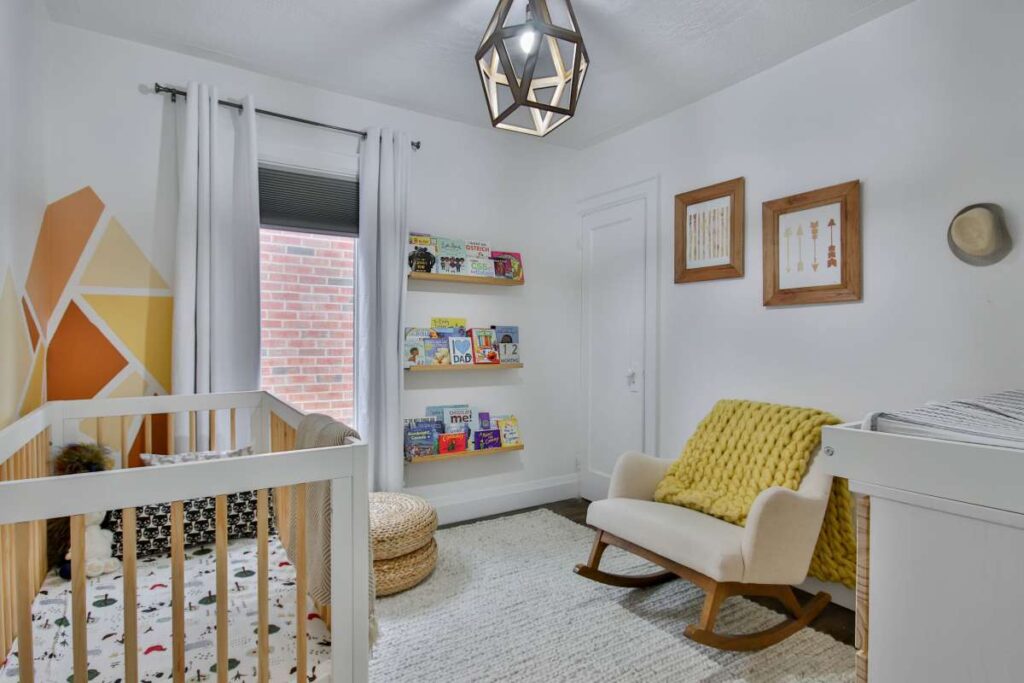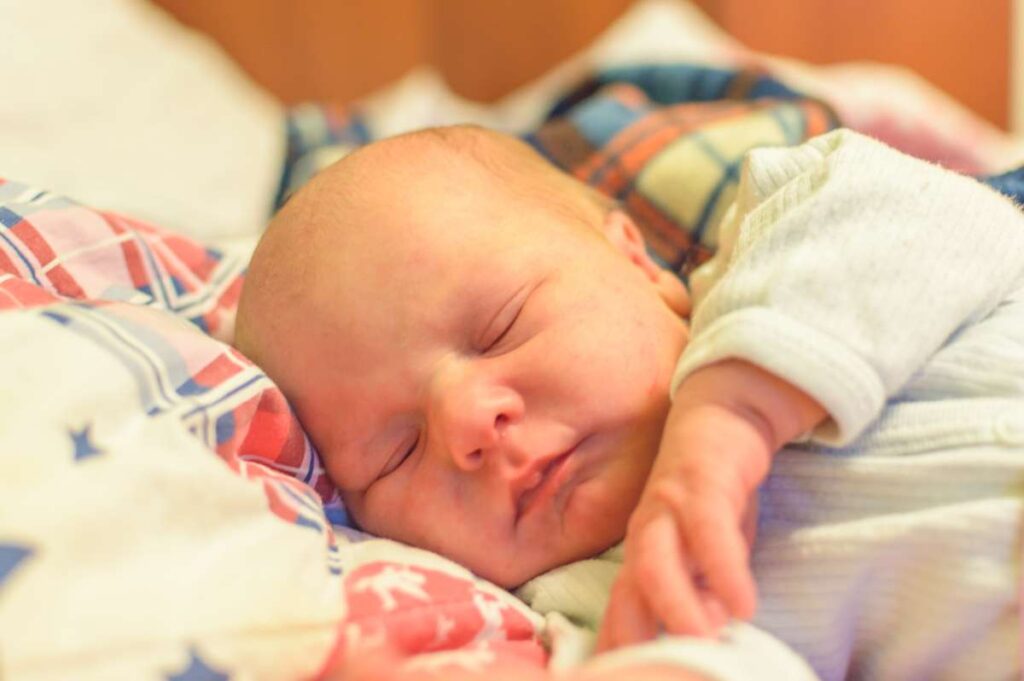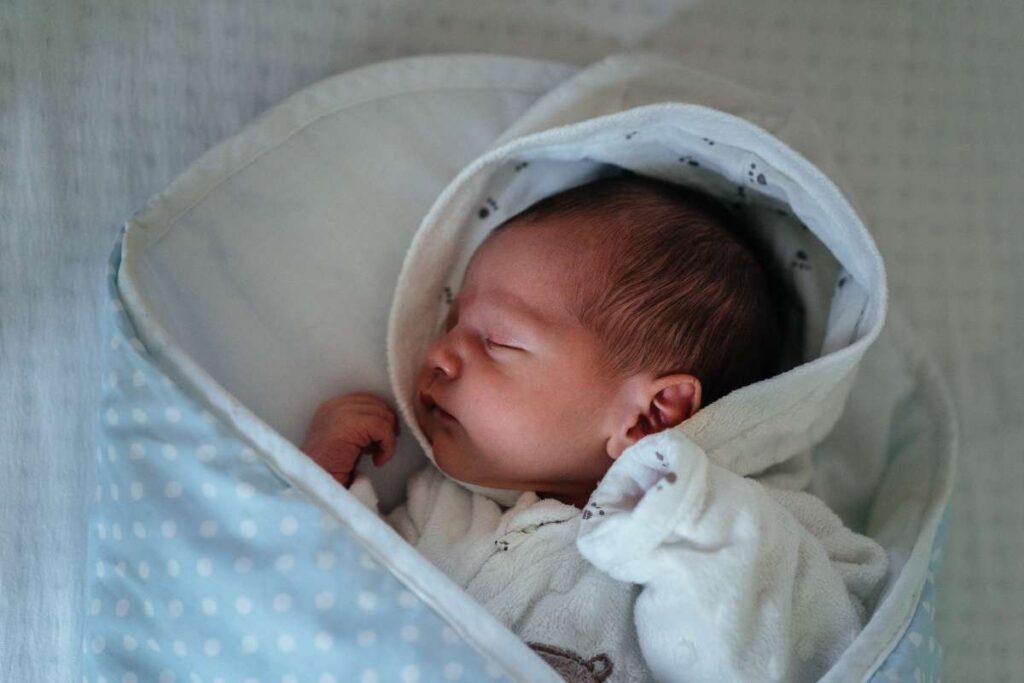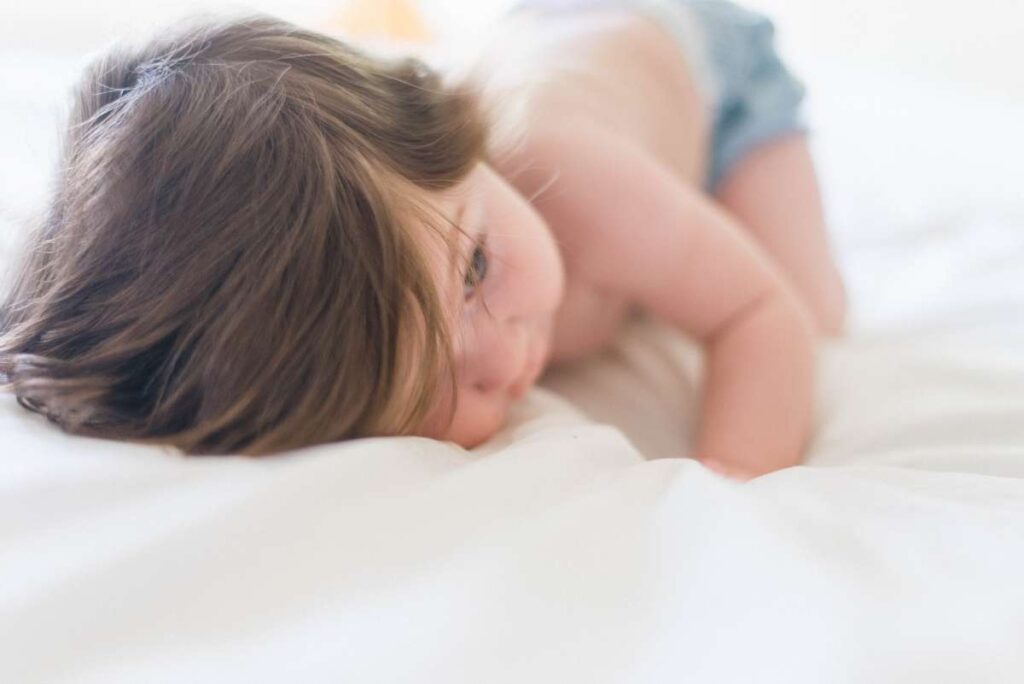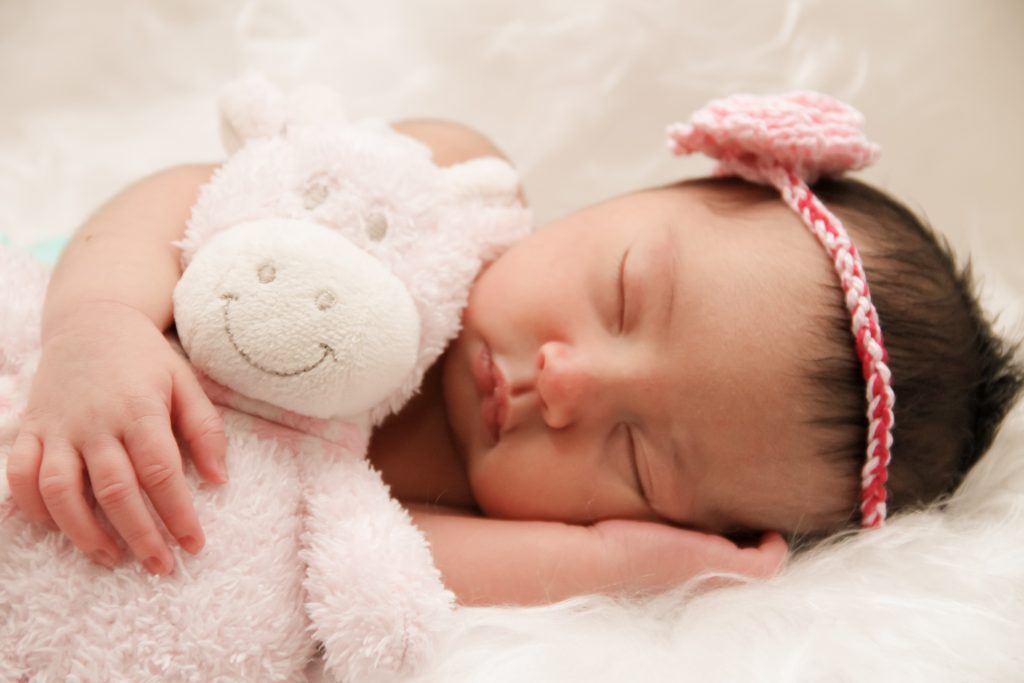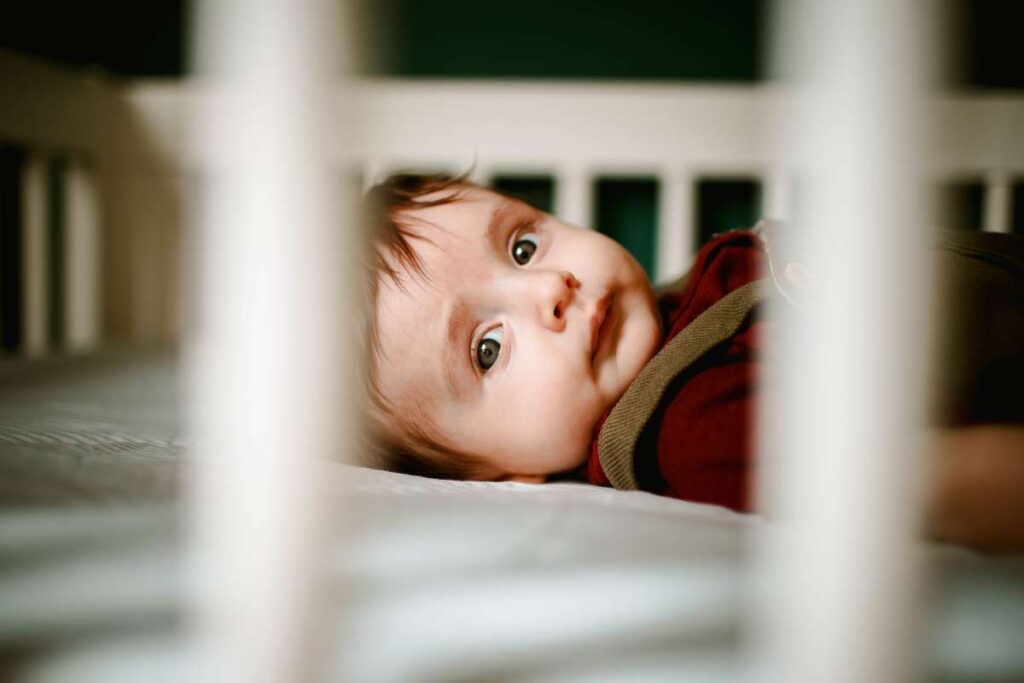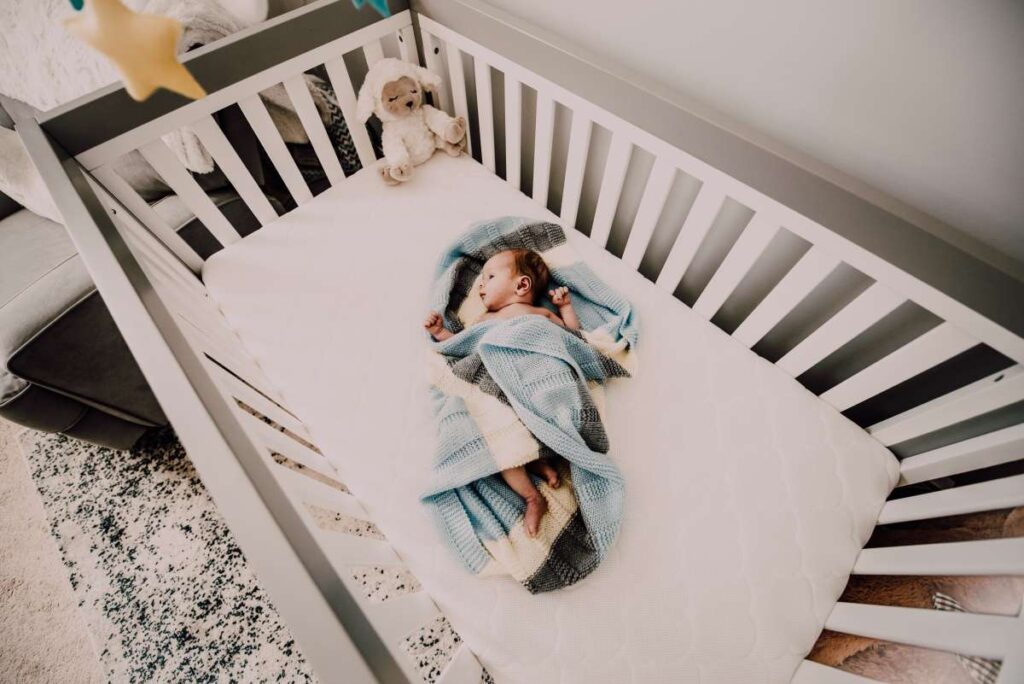Though constructing a crib for your infant may seem like a mundane daily activity, it is crucial that you take your time and do it right. To make sure your infant is as secure as possible when sleeping, follow the advice provided below from SIDS and Kids Australia's Safe Sleeping Guidelines.
Never put your infant to sleep in an unsafe crib, whether it be brand new or a hand-me-down; whether at home, in a daycare, or at a relative's house.
Make sure that:
- The gaps between the slats are no more than 2-3/8 inches (6 centimetres) and there are no broken, loose, splintered, or missing planks.
- The headboard and footboard don't have any openings the baby could get stuck in.
- There is not a single edge that is sharp or rough.
- The compartments close safely with the latches.
- Children are unable to open drop-side latches.
- All screws have been properly installed, and there are none that are protruding.
- The maximum height of the securely fastened corner posts is 1/16 inch (1.5 millimetres).
Specifically, you should check that:
- The fitted sheet for the crib is a perfect fit (never use an adult sheet).
- There should be no more than a half an inch of space between the mattress and the crib's side rails.
- As soon as your child is able to stand unassisted, the mattress should be returned to its lowest setting.
- The bed's mattress is not fluffy but rather hard.
- No stuffed animals, blankets, comforters, or pillows (whether they be standard adult pillows, decorative throw pillows, or infant doughnut pillows) should ever be left in a baby's crib.
- The crib lacks any sort of protective bumpers.
- There are no toys or mobiles hanging over the cot that have strings or ribbons longer than 7 inches (18 centimetres).
- When the infant reaches the age of five months or when they begin to push themselves up on their hands and knees, the mobile is taken away.
You may want to verify that:
- No dangerous drapery or window shade cables are within the baby's reach or near the cot.
- No recall has been issued for the crib.
FAQs About Baby Crib
No more than 2 3/8 inches (about the width of a soda can) between crib slats so a baby's body cannot fit through the slats; no missing or cracked slats. No corner posts over 1/16th inch high, so a baby's clothing cannot catch. No cutouts in the headboard or footboard so a baby's head cannot get trapped.
Your baby will spend a lot of time in the crib, napping during the day and sleeping at night. It's very important to make sure it's always a safe environment. Always place your baby to sleep on their back to help prevent sudden infant death syndrome (SIDS).
Most babies transition into the crib between 3 months to 6 months. If your baby is still sleeping peacefully in the bassinet, it might not be time to rush into transitioning the baby to a crib. But the longer you can determine the resistance encountered with your baby.
Safe sleep can help protect your baby from sudden infant death syndrome (also called SIDS) and other dangers, like choking and suffocation. Put your baby to sleep on his back on a flat, firm surface, like in a crib or bassinet.
A crib is defined by Merriam Webster as a small child's bedstead with high enclosing, usually slatted, sides. Cribs are a safe option for keeping older babies in their beds. And while they come in various styles, shapes, and sizes.
Baby's Crib Too High? Here Are Some Warning Signs
Knowing when your baby's cot needs to be lowered to prevent injury is crucial. Approximately 10,000 infants and toddlers are treated for injuries sustained in cribs each year, and many of these incidents involve the kid being injured after being thrown out of the crib. Whenever a baby reaches the point where he or she can stand up in the crib, there is a high risk of injury or death.
In her line of work as a paediatrician, she supposedly recommends that parents lower their child's crib before they actually feel the need to.
Children reach developmental milestones at different ages, so Gold suggests waiting until around six months, but no later than nine months. "Some children are sitting (unassisted) by the age of six months, whereas others do not achieve this milestone until the age of nine months."
This in mind, here are a few more indicators that your baby has outgrown their crib.
- They're attempting to use their hands and feet to get themselves upright. There's hope they can use this to launch themselves over the side of the crib if it has one.
- They're now 36 inches in height. This guideline comes from the American Academy of Pediatrics, which also suggests switching them to a toddler bed at this age.
Note that the American Academy of Pediatrics suggests a distance of 26 inches between the top of the crib mattress and the top of the rail. This is for the wellbeing of your infant.
Keep in mind that you can gradually lower the crib to the lowest setting if you choose. In order to comply with safety regulations and guidelines, a progressive reduction is acceptable.
The ability to gauge your baby's activity level and skills is important. That's the most reliable time frame for when you can safely lower your crib. If your baby is developing at a rapid rate, you may need to perform it earlier than expected.
Active infants, according to Gold, "may figure out a way to get their leg over the top and tumble out of the crib."
According to her experience, this occurs most often when the crib is not lowered and the child is already standing up in it while holding on.
You should also never use a crib that has a drop-side rail. These are considered dangerous by the American Academy of Pediatrics and should be avoided.
When considering when to lower the crib, you may have heard that some parents choose to place the mattress on the floor instead of the crib's base. This isn't something you should do unless your crib was designed for it.
Check the manual to see whether this is even a possibility. Most of the time, the crib's lowest setting is all that's needed. They probably need a toddler bed if they need it any lower.
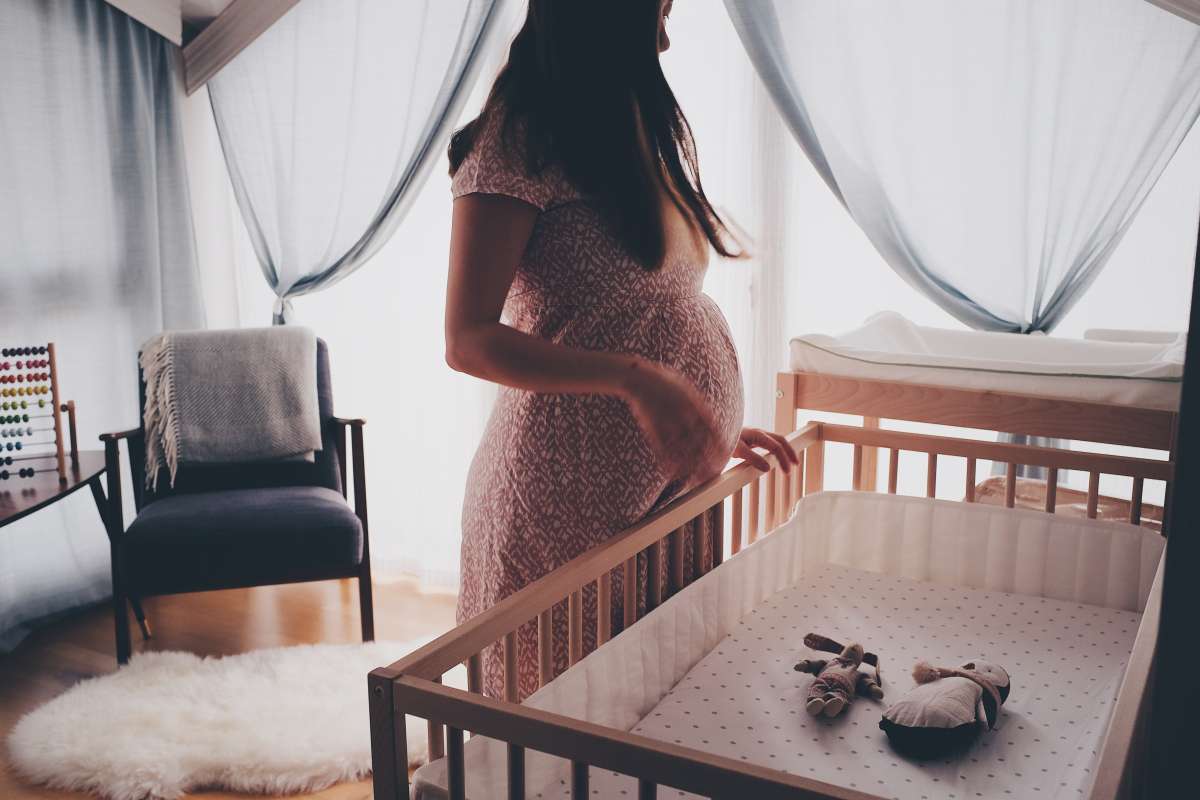
Baby's crib mattress should be lowered.
Since there is variation in the construction of cribs, you should refer to the manual that came with your model for specifics on how to accomplish this. When it comes to changing the height of the mattress, however, most cribs adhere to a standard set of guidelines.
- Set the crib's mattress to the desired height.
- Take away the bedsheets. Make sure you've removed the mattress cover and all other linens. Changing out the bed set will be less of a hassle. Also, never leave crib bumpers lying about. According to research conducted by the AAP, bumper pads might cause asphyxia. There is also the risk of suffocation and strangling if you use a quilt or other type of blanket.
- The mattress must be readjusted for comfort. By checking the crib's stability at each new mattress height with the aid of the manufacturer's guidelines, of course. Reversing the action of lowering the mattress at the foot of the crib requires the same action at the head.
- Prep the sleeping quarters. Now that the crib mattress is at a more manageable height for your child, you may return it to its normal bedding and mattress protector and tuck your child in for a restful night's sleep. To reduce the possibility of sudden infant death syndrome, always put your baby to bed on his back (sudden infant death syndrome).
At the same time you are lowering your baby's crib mattress, it is a good idea to check on the other safety features of the crib. This involves making sure there are no sags in the mattress and that it fits securely. You should also eliminate the potential for harm or garment snagging by removing the corner posts from the crib.
Imperilment of suffocation. You shouldn't let your baby play with these toys in the crib. Likewise, soft furnishings such as cushions, hefty blankets, and comforters should be avoided. Your baby's crib is not the place for any of these.
Make Sure Your Baby's Crib Is Safe
Keeping a baby safe requires many things, one of which is the correct use of a baby crib. Since you will be leaving your baby unattended in his or her crib on sometimes, it is crucial that you take the time to properly assemble it, utilise it, and understand the potential dangers it poses.
Babies can become irritable, hurt, or even die from SIDS if this product is used incorrectly (SIDS). Using a baby crib safely involves a number of measures.
Examining the Completed Crib
Put the crib together the right way.
When putting together the crib, be sure to carefully adhere to the manufacturer's instructions. Cribs for infants are required to meet stringent safety criteria during production.
- If you don't know what you're doing when putting together the crib, your infant could be in danger.
- If you have questions about how to use the product, please contact the retailer or manufacturer.
- If you're missing any components for the build, it's best to get in touch with the retailer or manufacturer.
- y crib.
Check the crib for any potential issues.
Inspect the crib for any potential choking hazards or locations a newborn could reach that shouldn't be there.
- Inspect the crib for any dangling or loose parts such as bolts, screws, joints, awnings, etc. that could cause the structure to topple over and hurt the baby.
- Take note of any rough areas or edges. Unevenly smoothed wood, sharp metal edges, and loose screws are all potential hazards in a crib.
- Verify the hooks that hold up the mattress. Make sure the child can't get trapped if the mattress were to flip over.
- To prevent the baby's body from falling out of the crib, make sure there are no spaces larger than two fingers between the mattress and the crib's side rails.
- To prevent a baby's clothing from snagging, corners should have no more than a 1/16-inch post.
For the safety of your infant, only use a bottom sheet that fits snugly in the crib
Again, check to make sure it is appropriate infant crib bedding.
- Take special care to ensure that the corners of the fitted crib sheet do not come loose. Otherwise, there's a risk of suffocating if this continues.
Always keep an eye out for crib recalls
Keep an eye out for updates and recalls to see if your crib is affected by evolving safety regulations and newly found issues.
- It's important to keep track of crib product serial numbers.
- Hold onto your warranty paperwork securely if you currently possess one.
- Be aware that a recall notice could come from the retailer, the manufacturer, or the government.
Put a bassinet to good use!
A bassinet is a less complicated alternative to a crib that is sometimes used for the first few months of life and even passed down from generation to generation.
- If you intend to use the bassinet again, give it a thorough cleaning first.
- Make sure the bassinet is securely affixed to its base. The bassinet or stand is most helpful when kept close to the parents' bed (s).
- Verify that there are no missing screws, sheets, or other linens in the bassinet and its base.
- Please only use the bassinet with the recommended mattress (or padding) and fitted sheet. Make sure the sheets you buy fit your mattress perfectly by checking the specifications.
- Stuffed toys and extra, loose bedding should not be included.
- Keep the bassinet free from any dangling cords or toys.
- Arrange your infant in the bassinet so that they are lying on their back.
- Babies who are able to sit up, climb, or otherwise move around independently should not sleep in bassinets.
Correct Use of a Crib
Position the crib appropriately.
A safer approach would be to stay away from any potential dangers to the infant.
- Babies can easily become entangled and strangled in window blind, curtain, or baby monitor cords, so keep those items well away from the crib.
- To reduce the risk of disease in the infant, the crib should not be placed near windows or doors.
- You should keep the baby's crib away from busy hallways or other places where noise could wake the baby.
- Please keep the crib away from any potential trip or fall hazards.
Make sure the infant is facing backwards in the crib.
The potential for harm is lessened in this way.
- This also holds true for those who like to snooze during the day as well as those who like to spend the night in bed.
- The mattress should be firm and securely fastened to the crib's structure.
- At least during the first several months, a crib should ideally be placed in the same room as the parent(s).
Switch to a sleeper instead of a blanket.
There is less of a chance of suffocation because the sleepers are not as thick as blankets, but they should still keep you toasty warm.
- It's important to make sure that the sleeper you buy fits the dimensions of the crib. If you are unsure, contact the maker of your crib.
- Avoid using extra blankets or sleepers since the baby could become entangled in them.
When using a blanket, position the infant so that his or her feet hang over the end of the crib.
It's important to make sure the baby's crib blanket won't come apart and trap the baby inside if you leave him or her in there.
- Wrap the baby's crib mattress in the blanket.
- The baby should be covered only to the chest.
Please keep in mind that the crib should be used for only as long as it is appropriate for your baby's age and size.
When a child reaches a certain height and maturity level, it may be time to transition them to a bed instead of a crib.
- Parents can postpone the change by raising the bed's side rails or reducing the height of the mattress, if possible (if possible).
- Between the ages of 1 1/2 and 3 1/2, the change often occurs.
- Having a "party" or letting the youngster choose the bed can help parents transition their child from the crib to a bed.
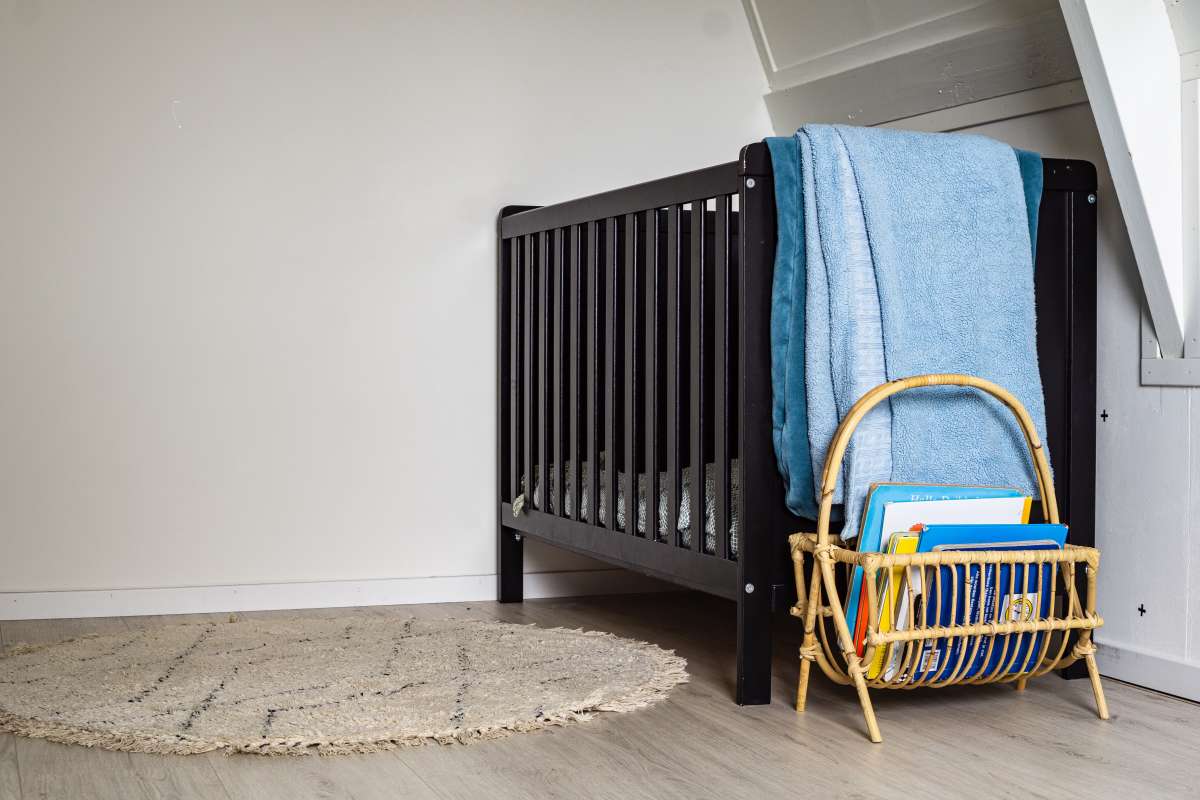
Crib Safety and Sudden Infant Death Syndrome Education
Know the signs of SIDS (Sudden Infant Death Syndrome).
When it comes to dangers faced by infants in their cribs, this is one of the most significant. The root of the problem is yet to be determined.
Premature and underweight newborns appear to be at a greater risk of SIDS.
Babies born to mums who didn't receive prenatal care, those whose mothers smoked during pregnancy, and those delivered as part of a multiple birth were all at a higher risk of Sudden Infant Death Syndrome.
Concerning slumbering in a crib, SIDS risk is increased when infants sleep on their bellies or sides (and roll over onto their bellies), as this position may restrict airflow and lead to suffocation.
Understand that there are no signs of sudden infant death syndrome.
Almost no early indicators exist.
- Babies who later die from SIDS have no obvious health problems.
- Many often, the bodies of those who have died of sudden infant death syndrome are discovered in the
- exact same posture as when they were placed in the bed.
Postmortem diagnosis of sudden infant death syndrome is the only way to be sure.
There is typically no other cause of death when a diagnosis of SIDS is made.
- The infant and parents' medical histories are examined by doctors.
- The baby's death scene will be examined by doctors.
- The procedure is followed by an autopsy.
Prevent sudden infant death syndrome by doing the following.
You can help lower the risk of sudden infant death syndrome by taking these precautions while caring for your baby in the crib, especially at night.
- A safe sleeping position for a baby is on his or her back. Inspect them at regular intervals to make sure they haven't rolled over.
- Babies should sleep in their own room with their parents for at least the first six months following birth (s).
- Be sure that your baby's crib has no extra items, such as blankets or toys, in it at any time.
- Regularly check the firmness of the crib mattress and the steadiness of its attachment to the base.
- Check to see that the sheet is securely fastened and not sliding off the mattress.
- At nap and sleep times, a pacifier may be helpful after your baby has been born for about a month.
Join a SIDS support group if you've experienced a tragedy
The cause of SIDS cannot be determined or prevented with certainty. Should the unthinkable occur, please consider participating in a grief support group.
- Seek out organisations that focus on helping families affected by sudden infant death syndrome.
- Try talking to a therapist about it.
- Confide in close friends, relatives, and religious leaders.
Conclusion
Never put your infant in an unsafe crib, whether it be brand new or a hand-me-down. Make sure that the gaps between the slats are no more than 2-3/8 inches (6 centimetres) and there are no broken, loose, splintered, or missing planks. Pamela Gold, a paediatrician, says parents should wait until their baby has outgrown their crib before lowering it. She suggests waiting until around six months, but no later than nine months. The American Academy of Pediatrics recommends a distance of 26 inches between the top of the crib mattress and the top rail.
Most of the time, the crib's lowest setting is all that's needed. Most cribs adhere to a standard set of guidelines for changing the height of the mattress. To reduce the possibility of sudden infant death syndrome, always put your baby to bed on his back. Babies can become irritable, hurt, or even die from SIDS if this product is used incorrectly. Cribs for infants are required to meet stringent safety criteria during production.
Using a baby crib safely involves a number of measures including inspecting the crib for potential hazards. Bassinets are a less complicated alternative to a crib that is sometimes used for the first few months of life. Babies who are able to sit up, climb, or otherwise move around independently should not sleep in bassinets. A crib should ideally be placed in the same room as the parent(s) during the first several months. When using a blanket, position the infant so that his or her feet hang over the end of the crib.
It's important to make sure the baby's crib blanket won't come apart and trap the baby inside if you leave him or her in there. Know the signs of SIDS (Sudden Infant Death Syndrome). Sudden infant death syndrome (SIDS) is a mystery disease. Almost no early indicators exist. Babies who later die from SIDS have no obvious health problems. You can help lower the risk of SIDS by taking these precautions while caring for your baby in the crib.
Content Summary
- Though constructing a crib for your infant may seem like a mundane daily activity, it is crucial that you take your time and do it right.
- To make sure your infant is as secure as possible when sleeping, follow the advice provided below from SIDS and Kids Australia's Safe Sleeping Guidelines.
- Never put your infant to sleep in an unsafe crib, whether it be brand new or a hand-me-down; whether at home, in a daycare, or at a relative's house.
- Specifically, you should check that: The fitted sheet for the crib is a perfect fit (never use an adult sheet).
- You may want to verify that: No dangerous drapery or window shade cables are within the baby's reach or near the cot.
- Whenever a baby reaches the point where he or she can stand up in the crib, there is a high risk of injury or death.
- In her line of work as a paediatrician, she supposedly recommends that parents lower their child's crib before they actually feel the need to.
- Children reach developmental milestones at different ages, so Gold suggests waiting until around six months, but no later than nine months. "
- Some children are sitting (unassisted) by the age of six months, whereas others do not achieve this milestone until the age of nine months."
- This in mind, here are a few more indicators that your baby has outgrown their crib.
- They're now 36 inches in height.
- Note that the American Academy of Pediatrics suggests a distance of 26 inches between the top of the crib mattress and the top of the rail.
- This is for the wellbeing of your infant.
- Keep in mind that you can gradually lower the crib to the lowest setting if you choose.
- The ability to gauge your baby's activity level and skills is important.
- That's the most reliable time frame for when you can safely lower your crib.
- Baby's crib mattress should be lowered.
- Set the crib's mattress to the desired height.
- At the same time you are lowering your baby's crib mattress, it is a good idea to check on the other safety features of the crib.
- Using a baby crib safely involves a number of measures.
- Examining the Completed Crib Put the crib together the right way.
- When putting together the crib, be sure to carefully adhere to the manufacturer's instructions.
- If you don't know what you're doing when putting together the crib, your infant could be in danger.
- y crib.
- Check the crib for any potential issues.
- Verify the hooks that hold up the mattress.
- Put a bassinet to good use!
- Make sure the bassinet is securely affixed to its base.
- Keep the bassinet free from any dangling cords or toys.
- Arrange your infant in the bassinet so that they are lying on their back.
- Correct Use of a Crib Position the crib appropriately.
- Please keep the crib away from any potential trip or fall hazards.
- Make sure the infant is facing backwards in the crib.
- Switch to a sleeper instead of a blanket.
- When using a blanket, position the infant so that his or her feet hang over the end of the crib.
- Wrap the baby's crib mattress in the blanket.
- Please keep in mind that the crib should be used for only as long as it is appropriate for your baby's age and size.
- Having a "party" or letting the youngster choose the bed can help parents transition their child from the crib to a bed.
- Crib Safety and Sudden Infant Death Syndrome Education Know the signs of SIDS (Sudden Infant Death Syndrome).
- Premature and underweight newborns appear to be at a greater risk of SIDS.
- Understand that there are no signs of sudden infant death syndrome.
- Postmortem diagnosis of sudden infant death syndrome is the only way to be sure.
- There is typically no other cause of death when a diagnosis of SIDS is made.
- The baby's death scene will be examined by doctors.
- Prevent sudden infant death syndrome by doing the following.
- You can help lower the risk of sudden infant death syndrome by taking these precautions while caring for your baby in the crib, especially at night.
- A safe sleeping position for a baby is on his or her back.
- Be sure that your baby's crib has no extra items, such as blankets or toys, in it at any time.
- Join a SIDS support group if you've experienced a tragedy The cause of SIDS cannot be determined or prevented with certainty.
- Should the unthinkable occur, please consider participating in a grief support group.
